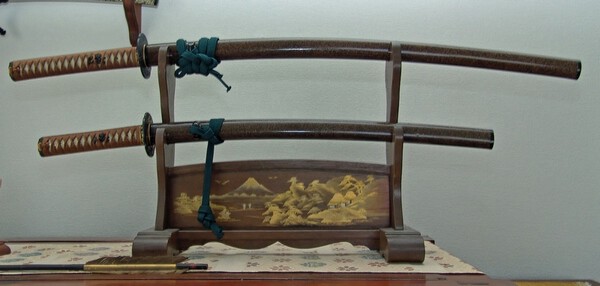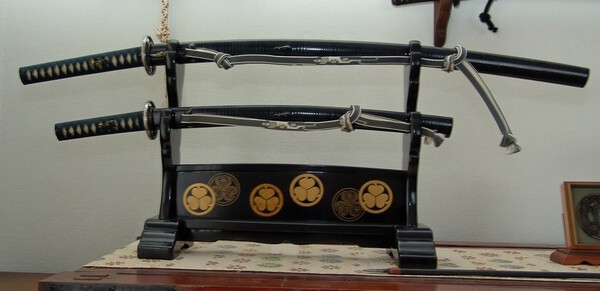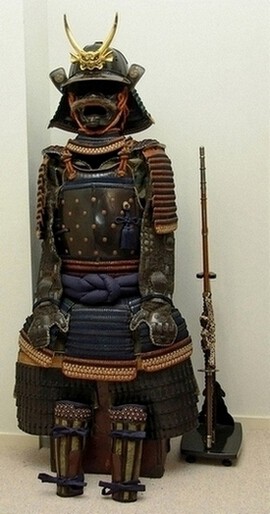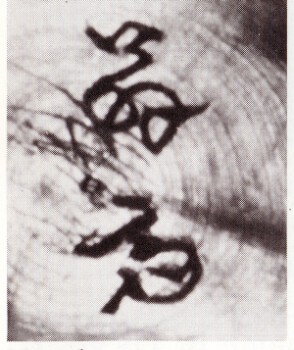-
Posts
3,242 -
Joined
-
Days Won
99
Content Type
Profiles
Forums
Events
Store
Downloads
Gallery
Everything posted by Guido
-
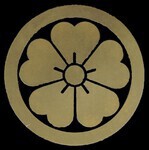
GINZA CHOSHUYA WEB MAGAZINE
Guido replied to Ichi's topic in Sword Shows, Events, Community News and Legislation Issues
If I recall correctly, Yen 12,000 a year. -

GINZA CHOSHUYA WEB MAGAZINE
Guido replied to Ichi's topic in Sword Shows, Events, Community News and Legislation Issues
Ginza Chôshûya is known for two things: a) good quality stuff, and b) high prices. -

This Week's Edo Period Corner
Guido replied to Bugyotsuji's topic in General Nihonto Related Discussion
You are right. "Takanashi" would be the more common reading, but "Takahashi" is correct. However, I'm in good (or maybe bad?) company: even the official Japanese website *Yokoso! Japan* get's it wrong: (http://www.west-Japan-travel.com/map/area_okayama.html, scroll all the way down). -

GINZA CHOSHUYA WEB MAGAZINE
Guido replied to Ichi's topic in Sword Shows, Events, Community News and Legislation Issues
I agree with the both of you. I'm a subscriber to their monthly catalog since 1990, and get twelve issues a year (that have much more info than the online version) for Yen 5,000. IMO you get a much better value there, and it shouldn't be that difficult to figure out the measurements etc. with even a minimal command of Japanese. -

This Week's Edo Period Corner
Guido replied to Bugyotsuji's topic in General Nihonto Related Discussion
Which one? (There are in fact some glitches due to them converting my Japanese fonts into Chinese fonts, but I don't see any in this particular description.) -

This Week's Edo Period Corner
Guido replied to Bugyotsuji's topic in General Nihonto Related Discussion
It has a late Kamakura period Aoe blade (but not in the Koshirae). Some classify Aoe as Bizen-den, others [including me] as Yamashiro-den. Btw, it's first sword on this page http://www.arscives.com/historysteel/japanese_swordlist.htm from the "History of Steel" exhibition in Macau. -

This Week's Edo Period Corner
Guido replied to Bugyotsuji's topic in General Nihonto Related Discussion
I, too, have seen done it both ways. I'm not sure if there really is a *right* or *wrong* way, even old paintings and woodblock prints are inconclusive. I personally am not concerned with the blade moving in the Saya: all my blades a safely stored, the Koshirae that is on display has Tsunagi instead. One (but not the most important) reason is that I like seeing my guests leaving without missing fingers and / or deep cuts. Getting the blood stains out of the carpet is a royal pain in the neck. -

This Week's Edo Period Corner
Guido replied to Bugyotsuji's topic in General Nihonto Related Discussion
I posted about the first Daishô on SFI five years ago: http://forums.swordforum.com/showthread.php?t=25155 It was a very interesting experience to coordinate the restauration, and I learned a lot about the different crafts involved along the way. -

This Week's Edo Period Corner
Guido replied to Bugyotsuji's topic in General Nihonto Related Discussion
-

This Week's Edo Period Corner
Guido replied to Bugyotsuji's topic in General Nihonto Related Discussion
-
I'm not sure anymore. Maybe I only *think* I killed him. Look at Freddy Krueger, Jason, and all the other guys: you think they're done for good, and before long there's a sequel. Think "Guido III".
-
Actually it says "wave dragon". Best Woody
-

This Week's Edo Period Corner
Guido replied to Bugyotsuji's topic in General Nihonto Related Discussion
-
There are very clear rules in regard to the time of production, Kanji used in the Mei, dating, horimono, length and so on that determine whether or not a sword is a Kazuuchimono. And if there aren't, there should be, preferably a law or something like that. And now it's our duty to chisel those rules in stone. Never - I repeat: *never!* - try to judge the blade itself, it will only confuse you (and think about all the wasted time that it takes to study what makes a sword a "good" or "bad" sword. Pffft. ).
-
Akiie / Masaie 晶家 and Okinatomi 翁富 are not listed in Lazarnick, Brockhaus, Davey etc. Masahiro 政廣 is, but the Mei looks *very* different. Okinatei 翁亭 is only mentioned in Bushell / Ueda, and Davey and Lazarnick think it's a misreading of Osai 翁齋 - which comes quite close to your signature, but I don't think it's a real match.
-
The Lazarnick books (http://www.amazon.com/NETSUKE-INRO-ARTISTS-Their-Signatures/dp/091706402X/ref=sr_1_5?ie=UTF8&s=books&qid=1197957299&sr=8-5) are the best source available for checking Netsuke signatures; I'll do just that when I get home tonight. However, I'm not exactly holding my breath in this case ... :?
-
In my experience, this kind of "scratched" (rather than properly carved), hard to decipher "Mei" in a cursive style is typical for carvers' marks in workshops. Not really a Mei per se, just marking one's carvings to count the output come payday. Also - although pictures can be deceiving - the ivory looks "smoked", a method to produce an artificial patina.
-

Taibundo
Guido replied to Ichi's topic in Sword Shows, Events, Community News and Legislation Issues
I actually gave it a short flick of my tongue while you were distracting the owner by discussing the Muramasa Tantô. Doesn't this give the expression "sword porn" an entire new meaning? -
And if you give them a high class polish, err, I mean bind them in a nice leather cover, a Shinsa might think they're written by Charles Dickens ... Other than that: add Shitahara to Reinhard's list.
-
Fujita Makoto is kind of a Japanese Gene Hackman: he can play almost any role convincingly. But Oda Yuji as Sanjuro??? Gimme a break! You won't see *me* at the movie theater tomorrow - I'll probably be at home, watching the original movie on DVD ...
-
Well, my opinion doesn't stand above any other just because I spent most of my adult life in Japan, basically spending any free minute with collectors, dealers and scholars of swords and fittings. However, I think that my explanation makes sense. Something that I don't see in most of the posts in this thread. Again, are there *any* historical documents, sketches, woodblock prints or the like that relate Bashin or Kogai to marking enemy heads or bleeding horses? If not, I have to assume that we're just dealing with urban legends and wild guesses, however emotional they might be. I'm sorry if this sounds kind of rude, but put up or shut up. BTW, my left ear lobe and right testicle are tattooed with a Masonic symbol; if I'm ever decapitated by the Yakuza (or Bōryokudan as they are officially called by Japanese police), authorities will be able to put the pieces together. Up to you: tall story or truth?
-
Ian, I hold you personally responsible for the hard work of cleaning my computer keyboard; it took me at least 20 minutes - using stacks of tissues and Q-tips - to remove the orange juice that gushed through my nose while reading your post. Not to talk about the burning sensation that the acids in the juice inflicted upon my upper respiratory system. Anyhow, there are a lot of urban legends, even in Japan, about Kogai and Bashin. While the latter is probably just another form of the Kozuka/Kogatana as a utility knife, I have yet to see any evidence that Bashin or Kogai where used to mark slain enemy's heads. From what I heard over the years, the Kogai was used to a) clean one's ears, and b) scratch your scalp. The Samurai had pulled back their oiled hair in an elaborate top-knot, usually not every day since that would have meant too many (expensive) trips to the barber shop, and it was the only way to scratch your head without messing up your hairdo. The Europeans did almost the same thing a couple of hundred years ago when wigs and heavy make-up were the norm, and bathing was unheard of. They carried little sticks with a carved "hand" at the end to scratch themselves - same principle. Certainly not as romantic or entertaining as the idea about sticking stuff into slain enemy's ears (so how many Kogai exactly did one have to take to the battlefield, just in case?) but much more plausible.
-
The Ōdachi linked in this thread - the so-called "Kibitsu-maru 吉備津丸" - was polished by Fujishiro Okisato 藤代興里 in 平成5年 (Heisei 5), and is depicted in his series "MEITŌ ZUKAN 名刀図鑑". It dosn't have a government classification per se, but is a Jūyō-Bunkazai of Okayama-ken. In any case, it wasn't made by the smith (or, rather, the lineage of smiths) discussed in this thread, Norimitsu 則光. It was made by Norimitsu 法光, also called "Hō no Norimutsu 法の法光" because of the different first character.
-
Koichi is 100% correct. Machi-okuri 区送: Hamachi and Munemachi are moved higher on the blade. Nakago-saki tsumeta Nakago 茎先つめた茎: only the Nakago itself is shortened, i.e. the tip section (or more) is cut off; the Mei is usually preserved. Suriage 磨上 (摺上) (or Suriage-nakago 磨上茎): the Nakago is shortend, and the Machi are moved up. A more correct term (but seldomly used) is "Nakago-saki-kiri-machi-okuri Nakago 茎先切区送茎". Ō-suriage 大磨上: both the Mei (if there was one to begin with) and the Ubu-yasuri are lost, i.e. the entire Ubu-nakago is removed. Sources: TŌKEN YŌRAN 刀剣要覧 by IIMURA KASHŌ 飯村嘉章 NIHONTŌ JITEN 日本刀事典 by TOKUNŌ KAZUO 得能一男 NIHONTŌ YŌGO JITEN 日本刀用語辞典 by KAJIHARA KŌTŌKEN 梶原皇刀軒 to name but a few.
-
Nope, I've never been to that part of Akita-ken. I also couldn't afford those expensive designer clothes ...


